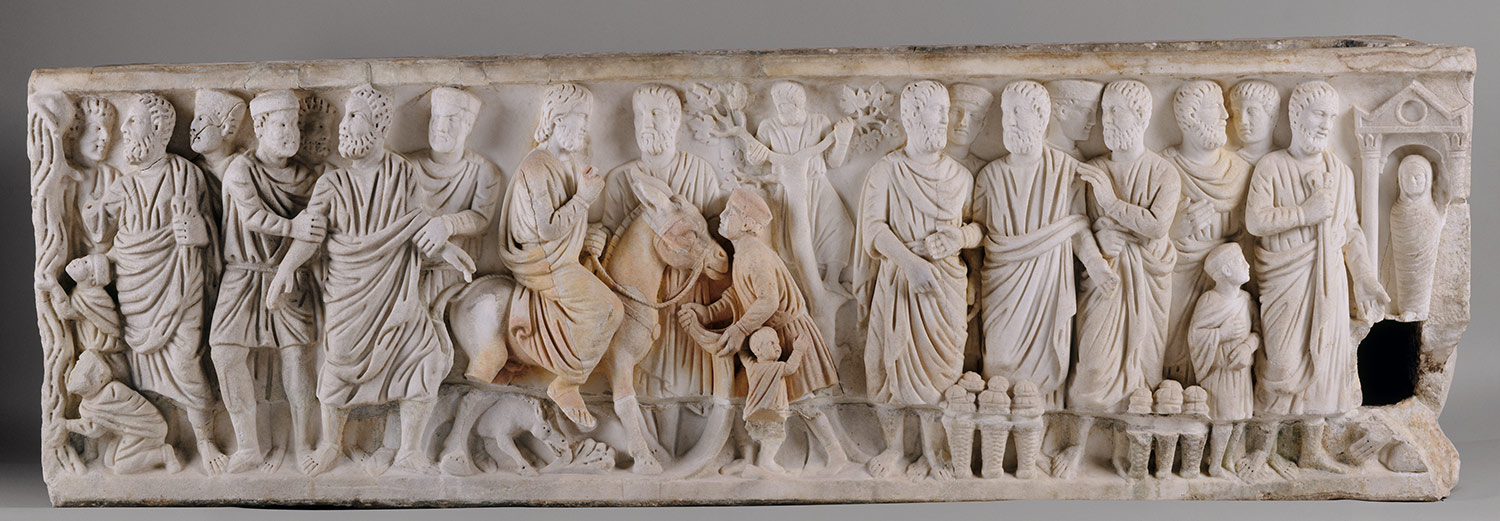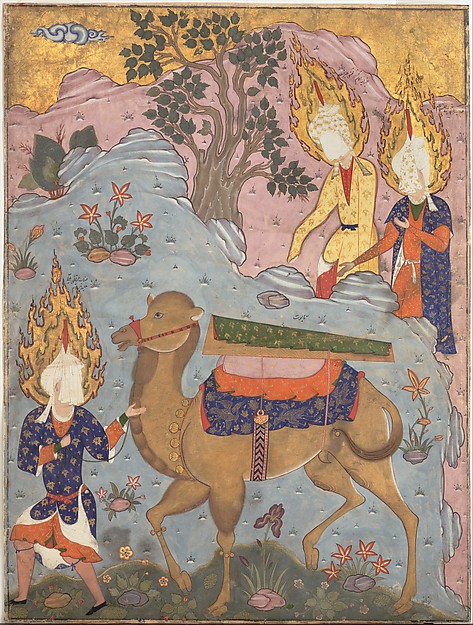Neelesh Manandhar
12/17/113
Block E History
The funerary rituals and art were very important to two very distinct empires in the early middle ages, the Byzantine and Islamic Empire. My first primary source for the Byzantine Empire is a marble sarcophagus that the early Byzantines used to bury their dead. According to the Metropolitan Museum of Art the sarcophagus contains depictions of the early life of Saint Peter and Christ. On the right side of the sarcophagus there are depictions of the scenes of life of Christ, the Entry into Jerusalem, the Multiplication of the Loaves, and the Raising of Lazarus. On the left side of the sarcophagus it portrays the legend of St. Peters, first his being arrested by Roman soldiers and then him in jail drawing water from a rock. According to the Metropolitan Museum of Art the second artifact is a painting that depicts the legend of Ali’s burial, in it Ali’s sons, Hasan and Husain, are behind the camel carrying the casket while Ali himself leads the camel. The Islamic method and rituals of death have many contrasting elements opposing the Byzantine culture such as the directness of the Islamic rituals versus the broader rituals and traditions of the Byzantine Empire.
According
to the Metropolitan
Museum of Art sarcophagi were first used in Roman culture in the early 2nd
century, however, the Greeks and Etruscans were the primary sarcophagus
builders and users and before the 2nd century Romans used cremation
instead of a sarcophagus. Before Rome
split in to Eastern and Western Rome their main system of religion was Greek
they would portray myths carved into the stone, wood or marble depending on how
rich they were. In Roman society decorated marble sarcophagi were considered
more lavish and were reserved for the elite, while the lower classes would only
be able to afford maybe a stone or wood undecorated sarcophagus. Increasingly
common later on in Christian funerals was a niche tomb which was an empty
decorated sarcophagus that would be placed next to or built into the wall of a
church while the actual body would be buried beneath the church. According to Qantary-Med,
the Eastern Orthodox religion of the Byzantine Empire has more traditions than
really rules, one of their traditions is to wash the body in order to “purify”
it another is to shroud the body in a linen cloth and point it towards the
door. The Byzantine Christians saw death more as a very slow process, for
example it was tradition to visit the grave site multiple times after their
death, this is seen as the body slowly passing away from life to death. There
are some stricter traditions such as during the funeral the traditional food
must be kollyva which is a traditional food that is eaten during the funeral.
According to Mission Islam the
Islamic or Muslim death rites have multitude of rules and regulations that must
be followed. One of the main rule in the Muslim community is there is no open
show of grief over a death of someone, for example there should be no wailing
or beating of the chest the only sign of grief should be crying. This is
probably because in the Muslim faith they believe that the spirit has gone to a
better place so there should not be any open sign of grief, also they believe
that the spirit can hear you so there should not be any sign of open grief
besides crying. Another one of the broader rules is that all Muslims should be
buried in the ground if possible, during the Ancient Islamic empire there were
ships and if a Muslim was to die at sea they would have to either wait until
they reach land to bury him or attach weights to the coffin and drop it
overboard. The Muslim faith, and therefore most of the Islamic empire, used the
actions and teaching of Muhammad to create the rules of Muhammad which is why
their rules are very strict and precise. For example one very strict rule for
burying the body that Al-Islam
states is the recommendation that the grave be rectangular and the one who lays
the body should be clean and bare-footed and enter the grave from the feet
side. Another very specific funeral
ritual stated by Mission Islam is if a relative or friend has died one must pay
off their debts, this rule started when Muhammad instructed a grieving relative
of a man to pay the two dinars he owed, because the prophet said this it has
become a rule. Contradictory with the painting, not all Muslims actually had a
coffin, instead they would just be wrapped in a shroud and placed in a grave,
this corresponds with the Muslim belief that all burial should be in the
ground.
1)
Islamic(Muslim) culture was much more strict
with funeral rites and practices
a)
Time of Funeral
i)
For example when one believes they are dying
they must repeat a special type of prayer
ii)
In the Christian Byzantine empire on the other
hand the funeral started after this person has died
b) Closing of Eyes
i)
Another is that in Islam one must close the eyes
because sight leaves after death
ii)
In Eastern Orthodox there is no mention of
closing the eyes but it is traditionally done, the contrasting element is that
it is a rule in the Muslim faith while in the Easter Orthodox faith it is
simply tradition to do so
c)
Shroud
i)
In Islam the body has to be wrapped in a white
shroud and should be wrapped an odd number of times
ii)
In the Eastern Orthodox faith people are
actually required to be wrapped in a linen shroud
d)
Debt
Paying
i)
In Islam the Prophet himself said that if you
are in close relation with the person who has died you must pay off his debt
ii)
In Eastern Orthodox there is no such rule
2)
Islamic culture there is no open grief
a)
Shrieking
i)
In Islam no open shrieks or wailing of the
person
ii)
In Eastern Orthodox some people will mutilate
themselves
b)
Graveyard Visiting
i)
In the Muslim faith there are strict rules of
even visiting the graveyard, before Muhammad said they could, some women were
not even allowed in the graveyard
(1)
Even when in graveyard one should not show open
grief ex. Wailing or shaving of the head.
ii)
In Eastern Orthodox faith anyone can visit the graveyards
and there are many displays of open grief even after someone’s passing from
years ago.
Conclusion Sentence
The ancient civilizations of both the Islamic and Byzantine
Empire have many contrasting elements, this is because of their differences of
religion and of their personal beliefs and morals.
Bibliography
"Sarcophagus with Scenes from the Lives of Saint Peter
and Christ [Roman]" (1991.366) In Heilbrunn Timeline of Art History .
New York: The Metropolitan Museum of Art, 2000–.
http://www.metmuseum.org/toah/works-of-art/1991.366. (October 2006)
"Coffin
of Imam 'Ali", Folio from a Falnama (The Book of Omens) of Ja'far Al-Sadiq.
1550-1560 AD. Metropolitan Museum of Art, New York City, NY. The
Book of Omens). N.p.: n.p., n.d.
N. pag. Web. 13 Dec. 2013. <http://www.metmuseum.org/Collections/search-the-collections/451017>.
"Taharat." Al-Islam.
Ahlul Bayt Digital Islamic Library Project, 1 Jan. 2013. Web. 16 Dec. 2013.
<http://www.al-islam.org/islamic-laws-ayatullah-al-uzma-sayyid-ali-al-husaini-seestani/taharat>.
Siala,
Mohamed Ebrahim. "Authentic Step by Step Illustrated Janazah Guide." Authentic
Step by Step Illustrated Janazah Guide. Mission Islam, n.d. Web. 16 Dec. 2013.
<http://www.missionislam.com/knowledge/janazahstepbystep.htm>.
Aisha,
Bibal Abu. "Funeral Rites and Regulations in Islam." Funeral
Rites and Regulations in Islam.
Mission Islam, n.d. Web. 16 Dec. 2013.
<http://www.missionislam.com/knowledge/funeral.htm>.
Awan, Heather T. "Roman
Sarcophagi". In Heilbrunn Timeline of Art History. New York: The
Metropolitan Museum of Art, 2000–. http://www.metmuseum.org/toah/hd/rsar/hd_rsar.htm
(April 2007)
Brooks, Sarah . "Art and Death in Medieval Byzantium". In
Heilbrunn Timeline of Art History. New York: The Metropolitan Museum of Art,
2000–. http://www.metmuseum.org/toah/hd/dbyz/hd_dbyz.htm (May 2010)
B, H. "Funerary Practices." Qantara
-Med. Qantara, 1 Jan. 2008. Web. 16 Dec. 2013.
<http://www.qantara-med.org/qantara4/public/show_document.php?do_id=1170>.


No comments:
Post a Comment